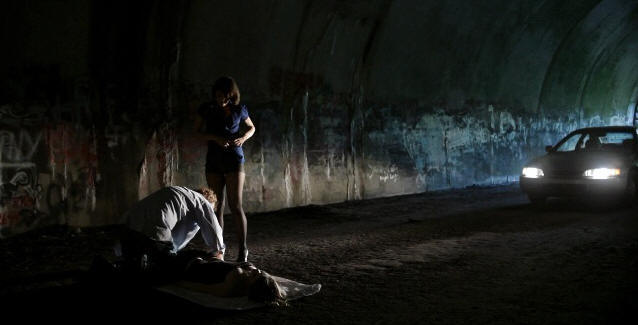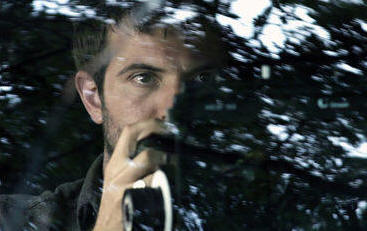MOVIE REVIEWS |
INTERVIEWS |
YOUTUBE |
NEWS
|
EDITORIALS | EVENTS |
AUDIO |
ESSAYS |
ARCHIVES |
CONTACT
|
PHOTOS |
COMING SOON|
EXAMINER.COM FILM ARTICLES
||HOME


Tuesday, July 26, 2011
MOVIE REVIEW
Road To Nowhere
The Road To A Dame, Paved With Bad Intentions

Shannyn Sossamon (standing) as Laurel Graham/Velma Duran in Monte Hellman's
"Road To Nowhere".
Monterey
Media
by
Omar P.L. Moore/PopcornReel.com
 FOLLOW
FOLLOW
Tuesday,
July 26, 2011
During the first ten minutes of Monte Hellman's "Road To Nowhere" we hear
gunfire. And clear, resonant music. We will see a woman in
silhouette: one of the film's most striking, suspenseful moments. A
strange, jaw-dropping event occurs. What are we watching? A movie
plays before us but to whom does its story belong? Mr. Hellman's
mysterious, perplexing, ingenious drama delves into grand 1940s noir and emerges
as a neo-noir classic.
Laurel Graham (Shannyn Sossamon) is prepping for a role in filmmaker Mitchell
Haven's movie dramatization of a political scandal and murder in North Carolina.
Velma Duran is a casualty in this sordid little mess of greed and corruption,
the truth of which entertainment and true-crime blogger journalist Nathalie Post
(Dominique Swain) is trying to get to the bottom of. Laurel plays Velma,
the lead role in Mitchell's film. Casting is key, Mitchell (Tygh Runyan)
reminds a film crew member. Mitchell does what a number of male directors
did in the 1940s and what some still do: he falls hard for his leading lady.
The presence of other characters is curious. We want to know more.
There's the cheekily-named character Cary Stewart (Cliff De Young), an actor
who plays a lead role in the film.
Packed with astute movie references that aren't idle, "Road To Nowhere" is all
about process: the process of moviemaking, the process of lies and the process
of revelation. Does the camera always lie? Does the actor?
Does fiction supersede fact? Is illusion sexier than truth? Who or
what reveals more, the camera or the actor? This film invites endless
questions. The ingredients Mr. Hellman's haunting film mixes are subtle,
bold and beautiful. Scenes are a jigsaw puzzle we have to assemble.
Which pieces are staged? Which are not? We become the film's editors
in an experience more interactive than nominally "interactive" movies are.
There are no buttons on a joystick to press here. "Road To Nowhere", which
occasionally chuckles at Robert Altman's "The Player" from its sidelines,
captures the artifice of truth and the reality of lies in ways that puts
"reality TV" to shame.
"Road To Nowhere" is as much a comment on the movies and the love this film has
for them as it is about the mystery that surrounds their making. The
script is on paper but actors shape and bring it to life, but whose life is
brought to life in the film? Mr. Hellman's masterpiece works as a great
"making-of" documentary: the making of myth and the uncovering of a crime that
exists in subterfuge. "Road To Nowhere" homogenizes and distinguishes at
the same time with its panoply of styles.
With all its events there's a strange neatness to "Road To Nowhere" that makes
the film oddly disconcerting yet necessary. The film's characters behave
like those rooted in 1940s noir. There's the classic femme fatale. There's
the boozy man who staggers but has cutting clarity. Note, for example, the
way Laurel changes her clothes for a date; how she removes shoes or stockings.
The cadence of those movements. The silence that surrounds them.
Silences that feel like breaths, tension and anticipation. Watching this
sublime presentation I felt like I was watching a dream unfold in someone else's
nightmares. And that's precisely what "Road To Nowhere" stages. The
film itself is not a "dream" but is a fantasy of truth, an infatuation gone
horribly wrong.

Tygh Runyan as Mitchell Haven
in Monte Hellman's neo-noir film "Road To Nowhere".
Monterey Media
Steven Gaydos expertly crafts the screenplay for "Road To Nowhere" and satirizes
the movie making business which he works in or at least knows much about as a
Variety magazine employee. Mr. Gaydos has collaborated with Mr. Hellman in
the past, and here he's written a gangbusters script that crackles with irony
and layered double-meanings. The screenplay is finely tuned to the ear of
each character and its speech is so disciplined. With all the high-stakes
poker this film plays characters never talk over each other. There are no
false notes in Mr. Hellman's drama; only characters' sour or foul ones.
The bookends of A-to-Z drama are ripped to shreds. What we're shown is the
alphabet soup in between. The marriage between life and art and fact and
fiction are blurred so thoroughly you are lost. Along the way lie
tell-tale clues about this film's destination, yet you are surprised by the
conclusion. The atmosphere of "Road To Nowhere" smolders. Tom
Russell's music has a soul that's lucid and so deeply connected to the movie and
its surroundings. The music is not background noise. This is a movie
that loves movies. And this is a movie I loved. A fascinating
experience, "Road To Nowhere" merits a second viewing and even a third, just
like the 2001 films "Memento" and "Mulholland Dr." did. What Mr. Hellman's
film does so well is use its unmistakable voice, one it confidently trumpets every step of
the way.
Mr. Hellman, who directed the classic "Two-Lane Blacktop" (1971) re-emerges from
a 21-year-feature film hiatus after "Better Watch Out!" in 1989 to direct a
near-flawless work. In some respects "Road To Nowhere" is a cousin to David Lynch's "Lost
Highway" (1997), one of that director's best movies.
The
similar lettering for both films' ads/posters is no accident.
"Lost Highway" involved a love affair, a crime, a metamorphosis and a man who
held powerful sway over key characters. Despite some similarities Mr.
Lynch's drama is more surreal, powerful and elusive, an obvious homage to
"Vertigo", and more potent than "Road To Nowhere", which includes a relevant
scene from "The Lady Eve" (1941).
Always entertaining, thought-provoking, and part-love story, "Road To Nowhere"
is filled with fine performances, especially from Ms. Sossamon in her dual
roles. She has to act as if she's acting -- but without appearing
to act as if she is. Ms. Sossamon doesn't parody, which would have been
lazy. She instead takes the challenging route, bringing nuance,
intelligence and complexity to two intriguing characters. That's a darn
difficult thing to do in such a multifaceted film, but Ms. Sossamon ("Wristcutters:
A Love Story") pulls it off seamlessly. It's a performance that merits
serious award consideration.
By the way, Ms. Sossamon looks a little like Linda Fiorentino, so good in "The
Last Seduction". As filmmaker Mitchell Haven Mr. Runyan has a staggering
likeness to Stanley Kubrick (whose birthday it is today), and played Mr. Kubrick
in a short film Mr. Hellman made five years ago. There's a scene in which
the actor is seen choreographing an image the way Mr. Kubrick did on several
sets.
"Road To Nowhere", which is pure, decorative art, seeks your immediate
attention. Mr. Hellman's film is speeding out of U.S. theaters quickly.
The big screen is where it must be seen. It's one of the year's very best
films. Oscar voters, please take note.
With: Waylon Payne,
John Diehl, Fabio Testi.
(Review also available
here at San Francisco Indie Movie Examiner)
"Road To Nowhere" is rated R by the Motion Picture
Association Of America for some language and brief violence. The film's
running time is two hours and two minutes.
COPYRIGHT 2011. POPCORNREEL.COM. ALL RIGHTS RESERVED.  FOLLOW
FOLLOW
SUBSCRIBE TO THE POPCORN REEL MOVIE
REVIEWS RSS FEED

MOVIE REVIEWS |
INTERVIEWS |
YOUTUBE |
NEWS
|
EDITORIALS | EVENTS |
AUDIO |
ESSAYS |
ARCHIVES |
CONTACT
| PHOTOS |
COMING SOON|
EXAMINER.COM FILM ARTICLES
||HOME


 FOLLOW
FOLLOW
 FOLLOW
FOLLOW